
Admiral Chester W. Nimitz
Overview
Chester William Nimitz, Sr. (February 24, 1885 – February 20, 1966) was a fleet admiral of the United States Navy. He played a major role in the naval history of World War II as Commander in Chief, U.S. Pacific Fleet and Commander in Chief, Pacific Ocean Areas, commanding Allied air, land, and sea forces during World War II.
Nimitz was the leading US Navy authority on submarines. Qualified in submarines during his early years, he later oversaw the conversion of these vessels' propulsion from gasoline to diesel, and then later was key in acquiring approval to build the world's first nuclear-powered submarine, USS Nautilus, whose propulsion system later completely superseded diesel-powered submarines in the US. He also, beginning in 1917, was the Navy's leading developer of underway replenishment techniques, the tool which during the Pacific war would allow the US fleet to operate away from port almost indefinitely. The chief of the Navy's Bureau of Navigation in 1939, Nimitz served as Chief of Naval Operations from 1945 until 1947. He was the United States' last surviving officer who served in the rank of fleet admiral.
WWII
Ten days after the attack on Pearl Harbor on December 7, 1941, Nimitz was selected by President Franklin D. Roosevelt to be commander-in-chief, United States Pacific Fleet (CINCPACFLT). He was promoted to the rank of admiral, effective December 31, 1941. Nimitz immediately departed Washington for Hawaii and took command in a ceremony on the top deck of the submarine Grayling. The change of command ceremony would normally have taken place aboard a battleship, but every battleship in Pearl Harbor had been either sunk or damaged during the attack. Assuming command at the most critical period of the war in the Pacific, Admiral Nimitz successfully organized his forces to halt the Japanese advance despite the losses from the attack on Pearl Harbor and the shortage of ships, planes, and supplies.
On March 24, 1942, the newly formed US-British Combined Chiefs of Staff issued a directive designating the Pacific theater an area of American strategic responsibility. Six days later, the US Joint Chiefs of Staff (JCS) divided the theater into three areas: the Pacific Ocean Areas, the Southwest Pacific Area (commanded by General Douglas MacArthur), and the Southeast Pacific Area. The JCS designated Nimitz as "Commander in Chief, Pacific Ocean Areas", with operational control over all Allied units (air, land, and sea) in that area.
Nimitz faced superior Japanese forces at the crucial defensive actions of the Battle of the Coral Sea and the Battle of Midway. The Battle of the Coral Sea, while a loss in terms of total damage suffered, resulted in the strategic success of turning back a Japanese invasion of Port Moresby on the island of Papua–New Guinea. Two Japanese carriers were temporarily taken out of action in the battle, which would deprive the Japanese of their use in the Midway operation that shortly followed. The severe losses in Japanese carriers at Midway affected the balance of naval air power during the remainder of 1942, and was crucial in neutralizing Japanese offensive threats in the South Pacific. Naval engagements during the Battle of Guadalcanal left both forces severely depleted. However, with the allied advantage in land-based air power, the results were sufficient to secure Guadalcanal. The US and allied forces then undertook to neutralize remaining Japanese offensive threats with the Solomon Islands campaign and the New Guinea Campaign, while building capabilities for major fleet actions. In 1943, Midway became a forward submarine base, greatly enhancing US capabilities against Japanese shipping.
Through 1943, Nimitz gained the materiel and manpower needed to launch major fleet offensives to destroy Japanese power in the central Pacific region. This drive opened with the Gilbert and Marshall Islands campaign from November 1943 to February 1944, followed by the destruction of the strategic Japanese base at Truk Lagoon, and the Marianas campaign that brought the Japanese homeland within range of new strategic bombers. Nimitz's forces inflicted a decisive defeat on the Japanese fleet in the Battle of the Philippine Sea (June 19–20, 1944), which allowed the capture of Saipan, Guam, and Tinian. His Fleet Forces isolated enemy-held bastions on the central and eastern Caroline Islands and secured in quick succession Peleliu, Angaur, and Ulithi. In the Philippines, his ships destroyed much of the remaining Japanese naval power at the Battle of Leyte Gulf, October 24 to 26, 1944. With the loss of the Philippines, Japan's energy supply routes from Indonesia came under direct threat, crippling their war effort.
By Act of Congress, passed on December 14, 1944, the rank of fleet admiral — the highest rank in the Navy — was established. The next day President Franklin Roosevelt appointed Nimitz to that rank. Nimitz took the oath of that office on December 19, 1944.
In January 1945, Nimitz moved the headquarters of the Pacific Fleet forward from Pearl Harbor to Guam for the remainder of the war. Nimitz's wife remained in the continental United States for the duration of the war, and did not join her husband in Hawaii or Guam.
In 1945, Nimitz's forces supported successful amphibious assaults on Iwo Jima and Okinawa, and launched raids against the home waters of Japan. In addition, Nimitz also ordered the United States Army Air Forces to mine the Japanese ports and waterways by air with B-29 Superfortresses in a successful mission called Operation Starvation, which severely interrupted the Japanese logistics.
On September 2, 1945, Nimitz signed as representative of the United States when Japan formally surrendered on board USS Missouri in Tokyo Bay. On October 5, 1945, which had been officially designated as "Nimitz Day" in Washington, D.C., Nimitz was personally presented a second Gold Star for the third award of the Navy Distinguished Service Medal by President Harry S. Truman "for exceptionally meritorious service as Commander in Chief, U.S. Pacific Fleet and Pacific Ocean Areas, from June 1944 to August 1945."
Post War
On November 26, 1945, Nimitz's nomination as Chief of Naval Operations (CNO) was confirmed by the U.S. Senate, and on December 15, 1945, he relieved Fleet Admiral Ernest J. King. He had assured the President that he was willing to serve as the CNO for one two-year term, but no longer. He tackled the difficult task of reducing the most powerful navy in the world to a fraction of its war-time strength, while establishing and overseeing active and reserve fleets with the strength and readiness required to support national policy.
For the postwar trial of German Grand Admiral Karl Dönitz at the Nuremberg Trials in 1946, Nimitz furnished an affidavit in support of the practice of unrestricted submarine warfare, a practice that he himself had employed throughout the war in the Pacific. This evidence is widely credited as a reason why Dönitz was sentenced to only 10 years of imprisonment.
Nimitz endorsed an entirely new course for the U.S. Navy's future by way of supporting then-Captain Hyman G. Rickover's chain-of-command-circumventing proposal in 1947 to build USS Nautilus, the world's first nuclear-powered vessel. As is noted at a display at the Nimitz Museum in Fredericksburg, Texas: "Nimitz's greatest legacy as CNO is arguably his support of Admiral Hyman Rickover's effort to convert the submarine fleet from diesel to nuclear propulsion."
From 1949 to 1953, Nimitz served as UN-appointed Plebiscite Administrator for Jammu and Kashmir. His proposed role as administrator was accepted by Pakistan but rejected by India.
Inactive Duty as a Fleet Admiral
Nimitz retired from office as CNO on December 15, 1947 and received a third Gold Star in lieu of a fourth Navy Distinguished Service Medal. However, since the rank of fleet admiral is a lifetime appointment, he remained on active duty for the rest of his life, with full pay and benefits. He and his wife, Catherine, moved to Berkeley, California. After he suffered a serious fall in 1964, he and Catherine moved to US Naval quarters on Yerba Buena Island in the San Francisco Bay.
In San Francisco, Nimitz served in the mostly ceremonial post as a special assistant to the Secretary of the Navy in the Western Sea Frontier. He worked to help restore goodwill with Japan after World War II by helping to raise funds for the restoration of the Japanese Imperial Navy battleship Mikasa, Admiral Heihachiro Togo's flagship at the Battle of Tsushima in 1905.
Nimitz was also appointed as the United Nations Plebiscite Administrator for Kashmir on 31 December 1948. The terms of the plebiscite were that Pakistan would vacate regions of Kashmir under its control, and that India would remove additional military from kashmir. But due to disagreements between the two regarding demilitarisation, the plebiscite is still pending.
Nimitz became a member of the Bohemian Club of San Francisco. In 1948, he sponsored a Bohemian dinner in honor of U.S. Army General Mark Clark, known for his campaigns in North Africa and Italy.
Nimitz served as a regent of the University of California during 1948–1956, where he had formerly been a faculty member as a professor of naval science for the Naval Reserve Officer Training Corps program. Nimitz was honored on October 17, 1964, by the University of California on Nimitz Day.
Death
In late 1965, Nimitz suffered a stroke, complicated by pneumonia. In January 1966, he left the U.S. Naval Hospital (Oak Knoll) in Oakland to return home to his naval quarters. He died at home at age 80 on the evening of February 20 at Quarters One on Yerba Buena Island in San Francisco Bay. His funeral on February 24 was at the chapel of adjacent Naval Station Treasure Island and Nimitz was buried with full military honors at Golden Gate National Cemetery in San Bruno. He lies alongside his wife and his long-term friends Admiral Raymond A. Spruance, Admiral Richmond K. Turner, and Admiral Charles A. Lockwood and their wives, an arrangement made by all of them while living.
Source: Wikipedia
Chester W. Nimitz
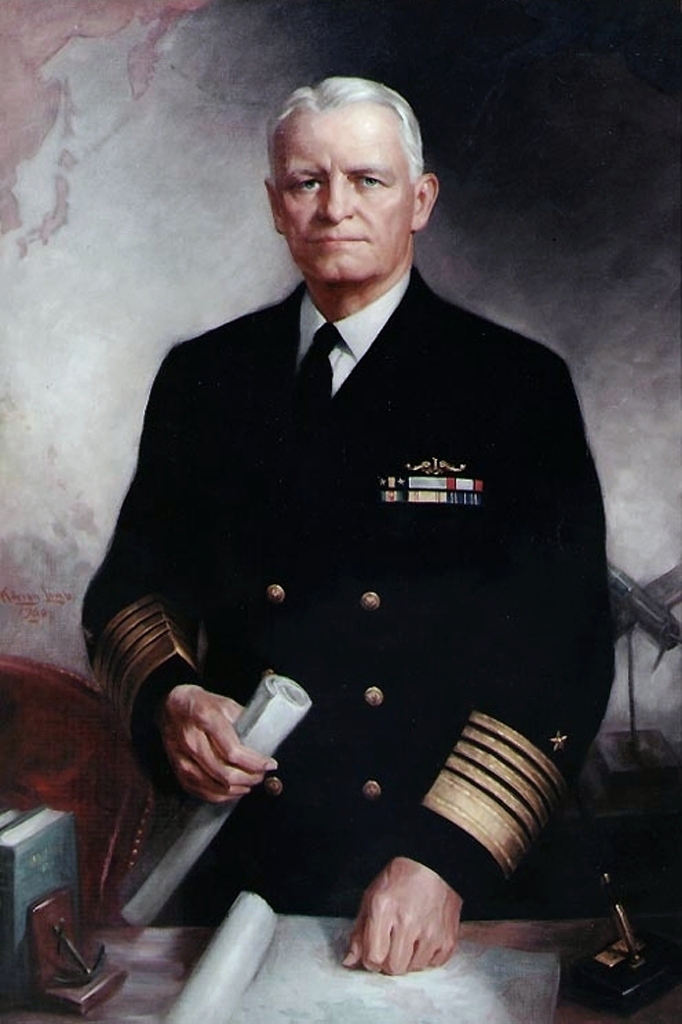
Portrait of Fleet Admiral Chester W. Nimitz
Click on any photo to zoom
Biography
Born:
Died:
Buried:
Service Branch:
Years of Service:
Rank:
Com-mands:
Battles/ Wars:
February 24, 1885
Fredericksburg, Texas, U.S.
February 20, 1966 (aged 80)
Yerba Buena Island, California, U.S.
Golden Gate National Cemetery
San Bruno, California, U.S.
United States Navy
1905-1966
Fleet Admiral
Chief of Naval Operations
Pacific Ocean Areas
United States Pacific Fleet
Bureau of Navigation
USS Augusta (CA-31)
USS Rigel (AR-11)
USS Chicago (CA-14)
Atlantic Submarine Flotilla
USS Skipjack (SS-24)
3rd Submarine Division Atlantic Torpedo Fleet
USS Narwhal (SS-17)
USS Snapper (SS-16)
USS Plunger (SS-2)
First Submarine Flotilla
USS Decatur (DD-5)
World War I
World War II
• Battle of the Coral Sea
• Battle of Midway
• Solomon Islands campaign
• Battle of the Philippine Sea
• Battle of Leyte Gulf
• Battle of Iwo Jima
• Battle of Okinawa
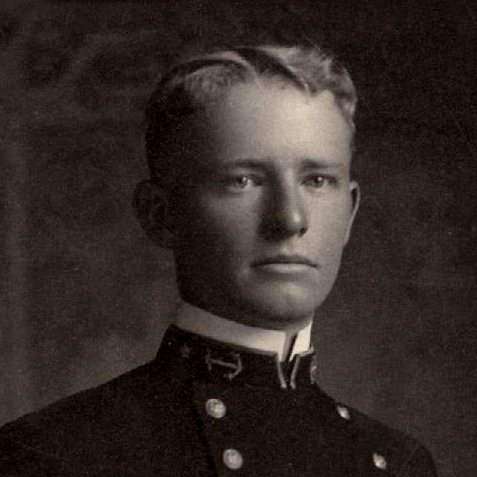
Midshipman 1/C Nimitz, circa 1905
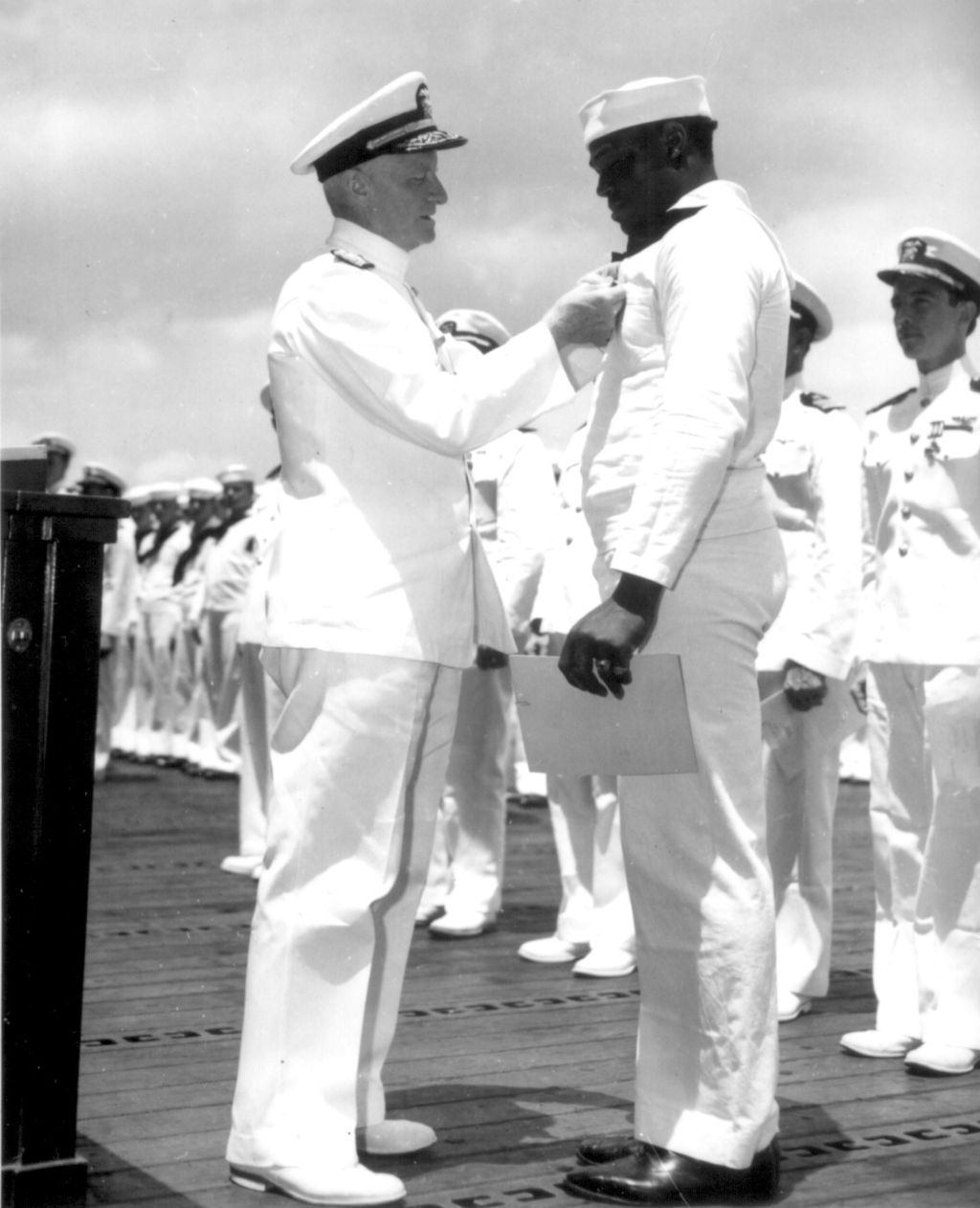
Admiral Chester W. Nimitz pins the Navy Cross on Doris "Dorie" Miller at ceremony on board USS Enterprise, Pearl Harbor, May 27, 1942.
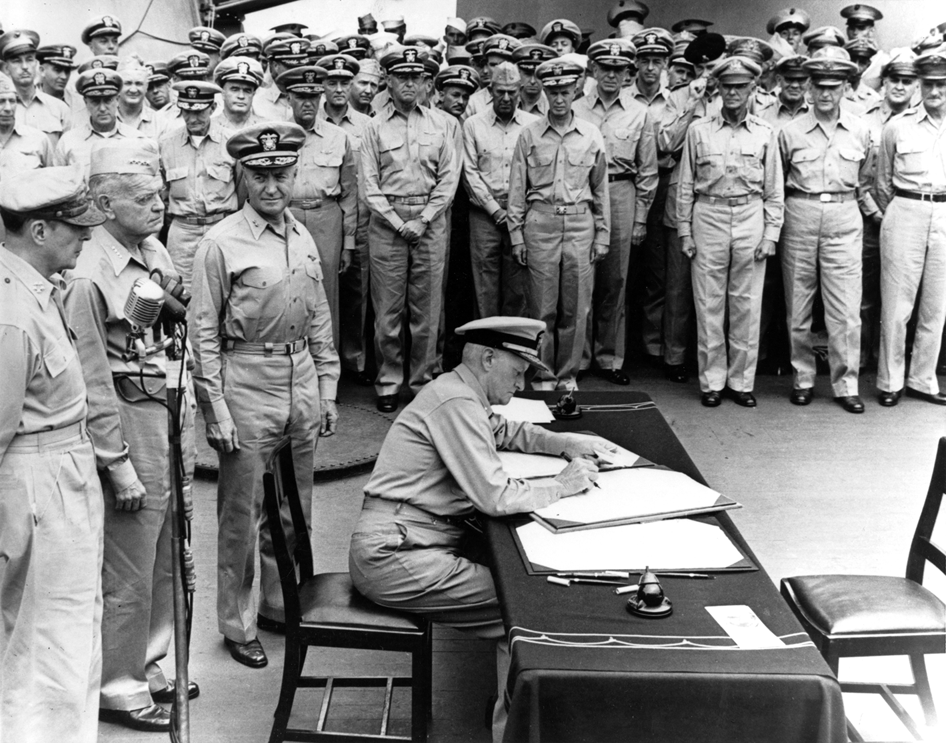
The surrender of Japan aboard USS Missouri in Tokyo Bay, September 2, 1945: Fleet Admiral Chester Nimitz, representing the United States, signs the instrument of surrender.
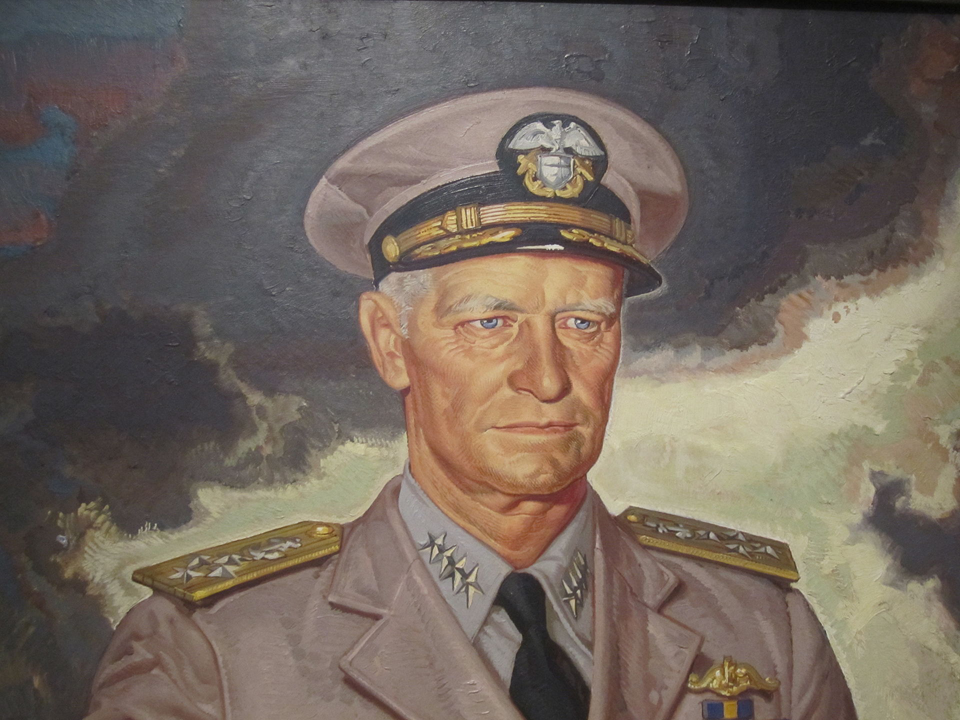
Nimitz as he appears at the National Portrait Gallery in Washington, D.C.


